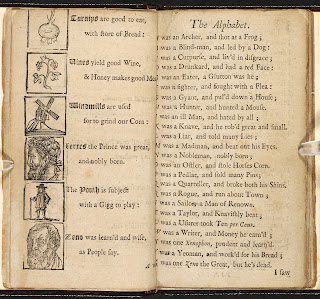'The Child's Plaything
I recommend for Cheating
Children into Learning'
N. Lovechild, Tommy Thumb's Pretty Song Book, 1744)
 |
| Sarah Trimmer, the influential critic of children's literature, Painted by Henry Howard, 1798 (Wikipedia) |
'...it is beyond Dispute, I suppose, that the Delight and Genius of Children, lies much towards the Hearing, learning, and Telling of Little Stories...we love to be instructed, as well as physick'd with Pleasure'
(Quoted in F.J. Harvey Darton Children's books in England, 1931 p.21)
Cheaper children's editions of his sugared pills, illustrated with crude woodcuts, became one of the books most widely read by children in the first twenty years of the 18th century, although his version of Aesop was eventually largely superseded by Samuel Croxall's, first published in 1722 with an extremely underhand attack on his rival translator in the preface:
'Pensioner to a Popish Prince..the Tool and Hireling of the Popish Faction.'(see Harvey Darton op.cit above)
The Croxall edition was, however, the one to be illustrated with woodcuts by Thomas Bewick around 1774 and is the many-times reprinted version most lucky children would have known.
 |
| 'It is a maxim in the schools That Flattery's the food of fools' (Bewick illustration for Aesop, Aesopica.) |
'But at length Mr. Newbery, of famous memory, stepped forth the professed friend of infancy and childhood...and he furnished a great supply of engaging books, by which curiosity was gratified, at the same time that religion, loyalty, and good morals were inculcated. '
(The Guardian of Education vol 1. p.62)
Newbery was active as a children's book publisher from c.1750 but he was not the first though he is the best known 18th century publisher of children's books. Harvey Darton mentions A little book for little children by T.W., a spelling book dating from between 1702 and 1712, of which only one known copy survives. It includes the famous rhyme 'A was an Archer and shot at a Frog' and the punctuation puzzle:
'I saw a Peacock with a fiery tail
I saw a blazing star that dropt down hail
I saw a Cloud begirt an Ivy round
I saw a sturdy Oak creep on the Ground...'
(see Harvey Darton op.cit p. 60 andThwaite, M.F. From Primer to Pleasure, 1963)
 |
| A Little Book for Little Children, 1702, with a picture of Queen Anne, reigned 1702-14 (British Library |
Page showing 'A was an Archer'
(British Library)
A Little Book, so nicely suited to the Genius and Capacity of a Little Child...that it will infallibly allure and lead him onto a Way of reading, published in 1712 by George Conyers is a similar work, and so is William Jole's The Father's Blessing, also published by Conyers. This suggests there may have been others published of which not a single copy has survived the rough handling of small owners and the other hazards which threaten the life of small, cheap books.(see Harvey Darton op.cit p. 62-3)
The publisher Thomas Boreman's miniature books for children also predate the earliest known children's books published by Newbery. His 'Gigantick histories', less that two inches high, describe the sights of London, and their aim is set out in the preface to Curiosities in the Tower of London, 1741:
'Too rigid precepts often fail,
Where short amusing tales prevail.
That author, doubtless aims aright,
Who joins instruction with delight...!'
 |
| One of Thomas Boreman's little books (Parker collection, Library of Birmingham) |
Mrs. Trimmer herself was fond of fairy tales as a child. She was born in 1741 and remembers 'as the delight of our childish days' Mother Goose's Fairy Tales, Aesop, Gay's Fables and The Governess, or Little Female Academy by Sarah Fielding, sister of the novelist Henry Fielding, first published in 1749, a narrative containing several linked fairy stories. (Guardian of Education op.cit p.62)
Mrs. Trimmer also mentions reading as a child The Spectator, The Guardian, The Tatler and, 'we are sorry to add', she says, novels.
Mrs. Thwaite in From Primer to Pleasure (1963) describes The Child's New Plaything, published by Mrs. Mary Cooper at the Sign of the Globe, Paternoster Row. A copy of the 2nd edition, 1743, has survived. The first surviving collection of nursery rhymes for children was also published by Mrs. Cooper.
A single copy of volume two of Tommy Thumb's Pretty Song Book, 1744? is in the British Library. It is bound in coloured and gilded paper boards of the kind later known as 'Dutch flowered' and printed in red and black on alternate pages, decorated with crude woodcuts. It includes the well known Lady Bird, Lady Bird fly away home, Oranges and lemons, Hickere, Dickere Dock, and London Bridge is falling down. On the last page is an advert for The Child's Plaything:
'The Child's Plaything
I recommend for Cheating
Children into Learning'
N. Lovechild
Sold by M. Cooper
Price one shilling
THE END
 |
| Tommy Thumb's Pretty Song Book, 1744? (British Library) |

No comments:
Post a Comment